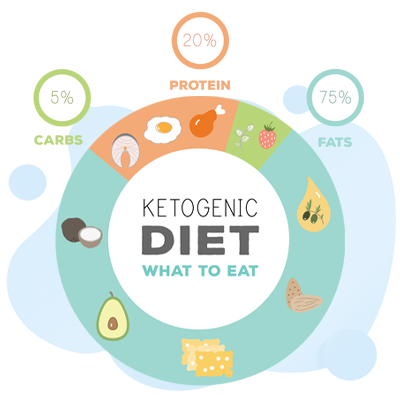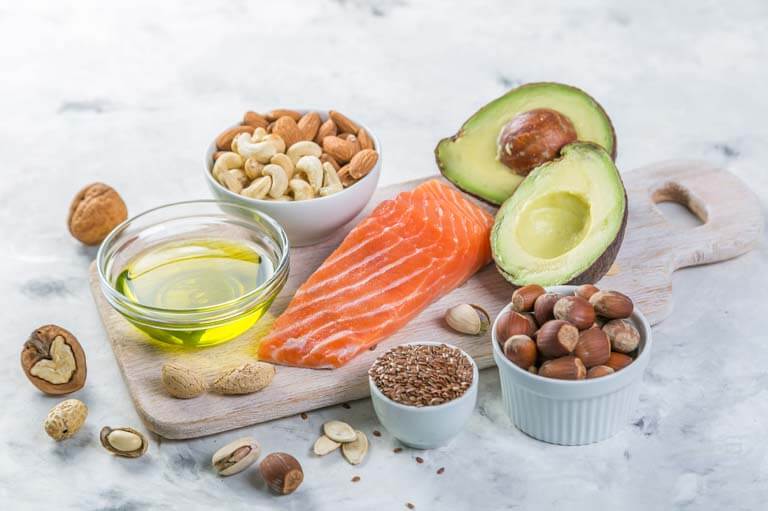Best Keto Diet Tips & Diet Plan Tricks 2023

The diet works by reducing the body’s supply of sugar. It will consequently start to digest fat for energy. As a result, the body produces molecules known as ketones, which it utilizes as fuel. When you consume fewer than 50 grams of carbohydrates daily, your body eventually runs out of quick-acting fuel (blood sugar). Normally, this takes three to four days. After that, you’ll begin converting protein and fat into energy, which may cause you to lose weight. It’s crucial to remember that the ketogenic diet is a temporary eating plan that prioritizes weight loss over the quest for health advantages.
Ketosis is the metabolic state in which ketone bodies build up in the blood. When fasting (such as sleeping through the night) or engaging in intense activity, healthy people naturally experience moderate ketosis. The brain will use ketones as fuel, and healthy people normally make enough insulin to prevent excessive ketones from accumulating. According to proponents of the ketogenic diet, blood levels of ketones should not rise to a dangerous level (known as “ketoacidosis”) if the diet is strictly adhered to.
Compared to other low-carb, high-protein diets, the protein intake on the ketogenic diet is maintained reasonably since consuming too much protein can hinder ketosis. A ketogenic diet demands enough protein to sustain lean body mass, including muscle. However, this will still result in ketosis because the amino acids in protein can be converted to glucose. When we overfeed on fats and cut off carbohydrates, our bodies become extraordinarily adaptable to what we feed them, and they start to burn ketones as their main source of energy.
Free Keto Diet Practice Test Online
The 10 Best Tips and Tricks for an Effective Keto Diet
The following tips and tricks will make your Keto Diet plan more attainable.
- Be Aware of the Foods You Eat
You will significantly restrict your carbohydrate intake if you stick to a keto diet. Begin by consuming 20 to 30 grams (g) of carbs daily. Additionally, be careful to understand which foods are high in carbs, fat, and protein so you can make the best decisions. For instance, carbohydrates aren’t merely found in foods like bread, pasta, chips, cookies, candy, and ice cream. Beans may have a high protein content, but they also have a lot of carbs. Most fruits and vegetables also contain carbohydrates. Only meat (protein) and pure fats like butter and oil.
- Consider How You Feel About-Fat Keto
Make tiny changes to your daily diet to be ready for a high-fat diet, which can initially be uncomfortable. For example, order a burger on lettuce leaves instead of fries and choose green vegetables instead of French fries. Choose a non-starchy vegetable for your side dish rather than potatoes or rice. Use extra oil in your cooking, such as avocado or olive oil. Recognize that your former eating habits, like grilling a simple skinless chicken breast, don’t work on the keto diet since you won’t consume enough fat.
- Protein Perspective
One of the biggest myths regarding the keto diet is that you may have as much protein as you want. But it would be best if you also regulated your protein consumption because this is not a diet where you manage your carbs.
- Make Fresh Food
Look through several keto websites and cookbooks to find delicious keto-friendly meals. Locate four to five recipes for dishes you are certain to enjoy. This way, you won’t be stuck wondering what to eat and turning to carbohydrates.
- Bulletproof coffee
This beverage, which you can make by combining coconut oil and butter with coffee, will help stave off hunger as you think about what to eat next. Keep in mind that coconut oil has the potential to cause LDL, or “bad,” cholesterol levels to skyrocket, so you’ll probably want to avoid this beverage if you have heart disease or are at an elevated risk for it due to a family history of the disease or your personal health history.
- Dietary objectives
Inform them of your plans. During family meals, you might not be able to consume what they are, so you should make them (and yourself) aware of your new eating habits. You can reassure them that this diet is only transitory because it is frequently followed for a brief period (three to six months).
- Potential side effects (Keto Flu)
Despite all the benefits of a ketogenic diet, such as weight loss, there is one significant drawback you must be aware of: the keto flu. The time after you begin the diet when your body is adjusting to using fat for energy is referred to as the “keto flu.” You can get severe muscle aches in your limbs for the first week or 10 days. The stairs may seem too steep to climb. You can have a mental haze. Due to a shift in fiber consumption, keto frequently results in constipation or, rarely, diarrhea.
- Increase Electrolytes
Your kidneys expel more water and electrolytes when you are in ketosis. Ensure that you’re getting the potassium and sodium your body requires for optimal performance. Eat non-starchy vegetables like asparagus, kale, bell peppers, and arugula, and season your food with salt. It would be best if you also drank the salted bone broth.
- Keto may not be the best option
With the popularity of ketogenic diets, other keto hybrid diets have emerged, including plant-based variations. (One is “ketotarian,” which primarily consists of plants but also allows for the consumption of eggs, ghee, fish, and shellfish.) Additionally, certain medical issues should cause you to reconsider adopting a ketogenic diet, or at the very least, consult your doctor before doing so. People include those taking insulin and oral and injectable drugs that aren’t insulin for high blood sugar or high blood pressure.
- Create a post-Keto plan
The keto diet is a temporary eating plan. Some people go on a keto diet for a brief period a few times a year, while others utilize it to lose weight and alter their eating patterns.
Best Keto Diet Pills
When following a strict diet, keto diet supplements might assist you in getting the nutrients you need. Additionally, some supplements have extra ketones, improving energy production and aiding in weight loss.
- Keto Charge
- Keto BHB Capsules
- E Sated Sucralose
- Elm & Rye Fat Burner
- Perfect Keto BHB Capsules

Plant Based Keto Diet
The most effective method to achieve this is to replace animal protein with plant protein, such as tofu and tempeh, and to keep your sources of fat from plant-based foods, like avocados, vegetable oil, olive oil, or flaxseed oil, while also being ready to eat a lot of nuts. This diet plant is friendlier to those who enjoy eating plant-based foods. It aims to accomplish the same goal as the typical ketogenic diet but with a stronger vegetarian emphasis.
Paleo vs Keto Diet
The paleo diet, sometimes known as “the caveman diet,” is founded on the idea that consuming foods that early humans would have had access to can improve health. The idea behind the paleo diet is that current food production and processing methods are bad for human health. In contrast, the keto diet, also known as the ketogenic diet, tries to cause ketosis by carefully balancing the intake of the three macronutrients: carbs, protein, and fat.
Paleo Keto Diet
Consuming animal fat and protein is the foundation of the paleo keto diet. It incorporates elements of the very low-carb ketogenic and paleo diets, mimicking our ancestors’ diets. The emphasis is on consuming wholesome, organic foods with a lot of energy from animal products.
Keto Liquid Diet
The Keto Liquid Fast is a modified 7-day protein-sparing fast that calls for a daily meal of four specialized keto-friendly protein shakes and a precisely scheduled supplement regimen to help you lose 1-2 pounds daily.
Carnivore Diet vs Keto
The carnivore diet goes one step further and completely bans all carbohydrate sources to make the body burn fat instead of carbohydrates. The keto diet is founded on the premise that your body uses carbs to produce energy, whereas the diet relies solely on consuming meat, which causes your body to burn fat first. The body resorts to burning fat in a process known as ketosis when carbs are not available. Plans for a ketogenic diet limit carbohydrates, especially simple sugars like those in candy, cake, and other sweets.
Is Keto a Fad Diet
Since it forbids consuming carbohydrates, the ketogenic diet is seen as a fad since it promises rapid weight loss and improved health. Since the Keto diet forbids reintroducing carbohydrates, it is far stricter than its fad diet predecessors, such as Atkins, the Zone, and South Beach.
Targeted Keto Diet
As described, the Targeted Ketogenic Diet (TKD) is just a conventional keto diet with the addition of eating carbohydrates right before and after workouts. That implies that you will consume carbohydrates every day that you work out. Make sure to include the additional calories from the carbs in your daily calorie intake if fat reduction is still your primary objective. This indicates that on certain days, fewer fats should be taken.
Cyclical Keto Diet
The cyclical keto diet alternates between a rigid high-fat, low-carbohydrate diet and a larger carbohydrate intake. Cyclical ketogenic dieting entails following a conventional diet program 5–6 days per week, then indulging in more carbs one-two day per week. Because they are designed to refill your body’s depleted glucose reserves, these higher-carb days are frequently referred to as “refeeding days.”
Is Keto Diet Good for Immune System
Despite the lack of clear studies, it indicates that the ketogenic diet can strengthen your immune system via;
- Reducing persistent systemic inflammation
- A reduction in fat mass
- Promoting blood sugar stability
- Enhancing immune cell performance
Keto Flex Diet
Keto Flex is a high-fat, moderately ketogenic diet that emphasizes consuming various plant-based foods and other nutrient-dense whole foods. It uses intermittent fasting as a natural approach to treating cognitive impairment that promotes brain health. Keto Flex is different from the typical ketogenic diet. As the name suggests, Keto Flex gives the body and brain the metabolic flexibility to burn glucose or ketones as fuel.
Agoge Diet vs Keto
Agoge means “Aggressive” in English. If it is an aggressive diet, the definition is “aggressive diet.” The agoge diet is a style of eating that focuses on consuming foods rich in fiber, healthy fats, and proteins from plants. The diet’s objectives are to support weight loss and enhance general health. While the ketogenic or “keto” diet has been used for centuries to address particular medical issues, it is a low-carb, high-fat diet.
Best Keto Diet Books
It’s a good idea to educate yourself before beginning a keto diet because changing your diet can impact many elements of your health, including your physical performance and electrolyte balance. The top keto books of 2023 are listed here.
- End Your Carb Confusion by Eric Westman and Amy Berger
- The Obesity Code by Jason Fung
- Ketotarian by Will Cole
- The Case for Keto by Gary Taubes
- Southern Keto by Natasha Newton
- The Wholesome Yum Easy Keto Cookbook by Maya Krampf
- The Ultimate Guide to Keto Baking by Carolyn Ketchum
- Simply Keto by Suzanne Ryan
- Metabolic by Robert Lustig
- The Big Fat Surprise by Nina Teicholz
- The Keto Diet by Leanne Vogel
Keto Green Diet
Keto-Green is a variation of the standard ketogenic diet. More alkaline vegetables are emphasized, especially low-carb green vegetables. The Keto-Green Diet’s main goal is to keep your body in ketosis, keep it alkaline, and make you feel attractive without causing unfavorable side effects like moodiness, keto flu, or nutrient deficiencies. A creative 16-day program combines the advantages of a ketogenic diet for fat loss with alkaline foods for brain cleaning and protection against the keto flu.